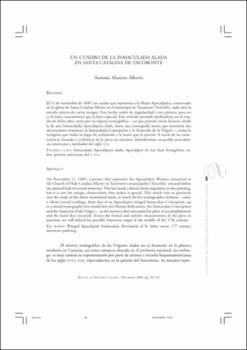Un cuadro de la Inmaculada alada en Santa Catalina de Tacoronte
Autor
Marrero Alberto, AntonioFecha
2008Resumen
El 11 de noviembre de 1685, un cuadro que representa a la Mujer Apocalíptica, conservado
en la iglesia de Santa Catalina Mártir en el municipio de Tacoronte (Tenerife), sudó ante la
mirada atónita de varios testigos. Este hecho rodeó de singularidad a esta pintura, pero no
es la única característica que la hace especial. Este artículo pretende profundizar en el estudio
de dicha obra, tanto por su riqueza iconográfica —ya que permite varias lecturas, desde
la de una Inmaculada Apocalíptica alada, hasta una iconografía mixta que mezclaría dos
advocaciones marianas: la Inmaculada Concepción y la Asunción de la Virgen—, como la
incógnita que rodea su lugar de realización y la mano que la ejecutó. A través de las características
formales y estilísticas de la pieza en cuestión, defenderemos su posible procedencia
americana a mediados del siglo XVII. On November 11, 1685, a picture that represents the Apocalyptic Woman, preserved in
the Church of Holy Catalina Martyr in Tacoronte’s municipality (Tenerife), sweated before
the amazed look of several witnesses. This fact made a detour from singularity to this painting,
but it is not the unique characteristic that makes it special. This article tries to penetrate
into the study of the above mentioned work, so much for her iconographic richness —since
it allows several readings, from that of an Apocalyptic winged Inmaculate Conception, up
to a mixed iconography that would mix two Marian dedications: the Immaculate Conception
and the Asuncion of the Virgin—, as the mystery that surrounds her place of accomplishment
and the hand that executed. Across the formal and stylistic characteristics of the piece in
question, we will defend his possible American origin in the middle of the 17th century.





